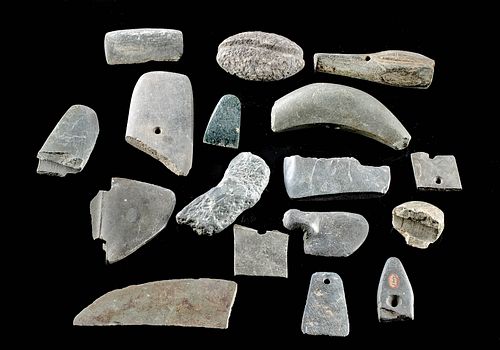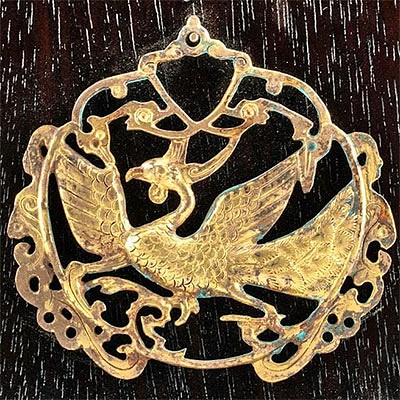16 Native American Stone Pieces & 1 Maya Jadeite Celt
Lot 253
About Seller
Artemis Fine Arts
686 S Taylor Ave, Ste 106
Louisville, CO 80027
United States
Selling antiquities, ancient and ethnographic art online since 1993, Artemis Gallery specializes in Classical Antiquities (Egyptian, Greek, Roman, Near Eastern), Asian, Pre-Columbian, African / Tribal / Oceanographic art. Our extensive inventory includes pottery, stone, metal, wood, glass and textil...Read more
Estimate:
$2,000 - $3,000
Absentee vs Live bid
Two ways to bid:
- Leave a max absentee bid and the platform will bid on your behalf up to your maximum bid during the live auction.
- Bid live during the auction and your bids will be submitted real-time to the auctioneer.
Bid Increments
| Price | Bid Increment |
|---|---|
| $0 | $25 |
| $300 | $50 |
| $1,000 | $100 |
| $2,000 | $250 |
| $5,000 | $500 |
| $10,000 | $1,000 |
| $20,000 | $2,500 |
| $50,000 | $5,000 |
| $100,000 | $10,000 |
| $200,000 | $20,000 |
About Auction
By Artemis Fine Arts
Jun 17, 2021
Set Reminder
2021-06-17 10:00:00
2021-06-17 10:00:00
America/New_York
Bidsquare
Bidsquare : Ancient & Ethnographic Art Through The Ages
https://www.bidsquare.com/auctions/artemis-gallery/ancient-ethnographic-art-through-the-ages-7094
Ancient art from Egypt, Greece, Italy and the Near East, as well as Asian, Fossils, Pre-Columbian, Native American, African / Tribal / Oceanic, Fine art, and much more! All categories, all price ranges... all legally acquired and guaranteed to be as described or your money back. Artemis Fine Arts info@artemisfinearts.com
Ancient art from Egypt, Greece, Italy and the Near East, as well as Asian, Fossils, Pre-Columbian, Native American, African / Tribal / Oceanic, Fine art, and much more! All categories, all price ranges... all legally acquired and guaranteed to be as described or your money back. Artemis Fine Arts info@artemisfinearts.com
- Lot Description
Native American, eastern and midwestern North America, late Archaic to early Woodlands periods, ca. 2000 BCE to 200 CE; Pre-Columbian, Mexico and Guatemala, Maya Territories, Late Classic, ca. 550 to 900 CE. An exemplary grouping of 17 stone tools, celts, and pendants; 16 black and grey stones from the North American late Archaic to early Woodlands periods and 1 greyish-green jadeite celt from the ancient Maya. Four of these remarkable artefacts present flat bodies of slate-like stone with a drill hole through their faces, suggesting that they were likely adze or axe heads. Another similar stone appears to have split at the site of its horizontal drill hole. A sixth stone does not feature an aperture, but instead a rectangular form and tapered edges, implying that it had a similar function. One more impressive piece is also slate-like with no hole and a long body that tapers to a point, perhaps having previously served as a knife. Size of largest: 5" L x 1.75" H (12.7 cm x 4.4 cm)
Four additional examples each display one concave edge, indicating that they are halves of adze or axe heads that split at their vertical drill holes. Similarly, another stone showcases one rounded face and one flat face with a semicircular perforation on one end of its flat face, hinting that it may have also split at its vertical drill hole. A thirteenth stone exhibits a lengthy body that is flat on one side with a recessed center, a vertical drill hole, and decoratively incised peripheries, suggesting it may have been part of a pipe. One more example showcases an ovoid form and a recessed band that wraps around it lengthwise where it was likely strapped to a stick to be used as a hammer. Nearly complete, a lovely, smoothly carved stone boasts a curved body with pointed ends and a vertical drill hole, possibly having served as a type of pick. Lightest in color, the sixteenth stone has a rough body with a gentle curve. Alternatively, the Maya jadeite celt features a tapered edge and a thick, curved head, all in a rich shade of midnight green with sage-hued inclusions. Sanded smooth, this celt perhaps served a votive or ceremonial function.
The value of jade and jadeite for people in ancient Central America lay in its symbolic power: perhaps its color was associated with water and vegetation; the Maya would place jade and jadeite beads in the mouths of the dead. Many scholars have argued that the demand for jadeite contributed to the rise of long distance trading networks and to the rise of urban centers in ancient Mesoamerica.
Provenance: private Kansas City, Missouri, USA collection; ex-John Townsend collection, acquired in the 1970s and earlier
All items legal to buy/sell under U.S. Statute covering cultural patrimony Code 2600, CHAPTER 14, and are guaranteed to be as described or your money back.
A Certificate of Authenticity will accompany all winning bids.
We ship worldwide and handle all shipping in-house for your convenience.
#162028Thirteen stones are fragments or have significant losses. Collection label on one and collection number written on two. All have expected abrasions, nicks/chips, and scratches, commensurate with age and use. Otherwise, all are very nice.Condition
- Shipping Info
-
All shipping is handled in-house for your convenience. Your invoice from Artemis Gallery will include shipping calculation instructions. If in doubt, please inquire BEFORE bidding for estimated shipping costs for individual items.
-
- Buyer's Premium



 EUR
EUR CAD
CAD AUD
AUD GBP
GBP MXN
MXN HKD
HKD CNY
CNY MYR
MYR SEK
SEK SGD
SGD CHF
CHF THB
THB












